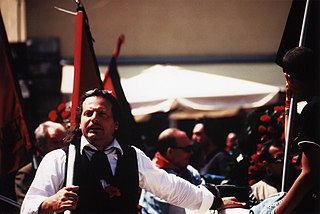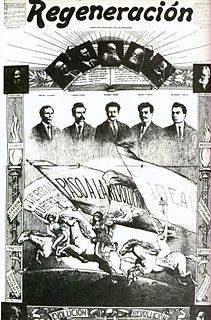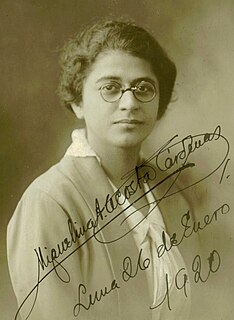Related Research Articles
Lina Marcela Medina de Jurado is a Peruvian woman who became the youngest confirmed mother in history when she gave birth aged five years, seven months, and 21 days. Based on the medical assessments of her pregnancy, she was less than five years old when she became pregnant, which was possible due to precocious puberty.

Cipriano Ricardo Flores Magón was a noted Mexican anarchist and social reform activist. His brothers Enrique and Jesús were also active in politics. Followers of the Flores Magón brothers were known as Magonistas. He has been considered an important participant in the social movement that sparked the Mexican Revolution.
Anarchists have employed certain symbols for their cause, including most prominently the circle-A and the black flag.
The Argentine Libertarian Federation is a libertarian communist federation which operates in Argentina, out of the City of Buenos Aires, San Pedro, La Pampa Province, and Rosario. Founded in October 1935 with the name of the Anarcho-Communist Federation of Argentina the FLA adopted its current name in 1955. It is governed by the Declaration of Principles and the Organic Charter approved by its congress. Its structure and operation are federative and are coordinated by Local Councils and the National Council.
Anarchism in the United States began in the mid-19th century and started to grow in influence as it entered the American labor movements, growing an anarcho-communist current as well as gaining notoriety for violent propaganda of the deed and campaigning for diverse social reforms in the early 20th century. By around the start of the 20th century, the heyday of individualist anarchism had passed and anarcho-communism and other social anarchist currents emerged as the dominant anarchist tendency.

Anarchism in France can trace its roots to thinker Pierre-Joseph Proudhon, who grew up during the Restoration and was the first self-described anarchist. French anarchists fought in the Spanish Civil War as volunteers in the International Brigades. According to journalist Brian Doherty, "The number of people who subscribed to the anarchist movement's many publications was in the tens of thousands in France alone."
Anarchism as a social movement in Cuba held great influence with the working classes during the 19th and early 20th century. The movement was particularly strong following the abolition of slavery in 1886, until it was repressed first in 1925 by President Gerardo Machado, and more thoroughly by Fidel Castro's Marxist–Leninist government following the Cuban Revolution in the late 1950s. Cuban anarchism mainly took the form of anarcho-collectivism based on the works of Mikhail Bakunin and, later, anarcho-syndicalism. The Latin American labor movement, and by extension the Cuban labor movement, was at first more influenced by anarchism than Marxism.
Italian anarchism as a movement began primarily from the influence of Mikhail Bakunin, Giuseppe Fanelli, and Errico Malatesta. Rooted in collectivist anarchism, it expanded to include illegalist individualist anarchism, mutualism, anarcho-syndicalism, and especially anarcho-communism. It participated in the biennio rosso and survived Italian Fascism. Platformism and insurrectionary anarchism were particularly common in Italian anarchism and continue to influence the movement today. The synthesist Italian Anarchist Federation appeared after the war, and autonomismo and operaismo especially influenced Italian anarchism in the second half of the 20th century.

Gaspar Jesús Melchor Flores Magón was a Mexican politician, journalist, and jurist. The more moderate brother of Ricardo and Enrique Flores Magón, he served in the cabinet of Francisco I. Madero.

Regeneración was a Mexican anarchist newspaper that functioned as the official organ of the Mexican Liberal Party. Founded by the Flores Magón brothers in 1900, it was forced to move to the United States in 1905. Jesús Flores Magón published the paper, while his brothers Ricardo and Enrique contributed articles. The Spanish edition of Regeneración was edited by Ricardo, and the English version by W. C. Owen and Alfred G. Santleben.

The Pariacaca mountain range, also called Huarochirí mountain range lies in the Andes of Peru. It is located in the Junín Region, in the provinces of Jauja and Yauli, and in the Lima Region, in the provinces of Huarochirí and Yauyos. It is part of the Cordillera Central of Peru.
Anarchism in Bolivia has a relatively short but rich history, spanning over a hundred years, primarily linked to syndicalism, the peasantry, and various social movements. Its heyday was during the 20th century's first decades, between 1910 and 1930, but a number of contemporary movements still exist.

The anarchist movement in Chile emerged from European immigrants, followers of Mikhail Bakunin affiliated with the International Workingmen's Association, who contacted Manuel Chinchilla, a Spaniard living in Iquique. Their influence could be perceived at first within the labour unions of typographers, painters, builders and sailors. During the first decades of the 20th century, anarchism had a significant influence on the labour movement and intellectual circles of Chile. Some of the most prominent Chilean anarchists were: the poet Carlos Pezoa Véliz, the professor Dr Juan Gandulfo, the syndicalist workers Luis Olea, Magno Espinoza, Alejandro Escobar y Carballo, Ángela Muñoz Arancibia, Juan Chamorro, Armando Triviño and Ernesto Miranda, the teacher Flora Sanhueza, and the writers José Domingo Gómez Rojas, Fernando Santiván, José Santos González Vera and Manuel Rojas. At the moment, anarchist groups are experiencing a comeback in Chile through various student collectives, affinity groups, community and cultural centres, and squatting.

Anarchism as a social movement is one of the manifestations of the political left within the working classes of Puerto Rico, having its peak during the late 19th and early 20th century. Anarchism was predominantly present within, but not exclusive to, the working classes that emerged as the sociopolitical environment changed. The municipalities of Caguas and Bayamón were the epicenters of the movement. It was also recorded in other industrial centers, such as Ponce, San Juan, Arecibo, Cayey, Cidra, Juncos, Vega Baja, Utuado, Lares, Yauco and Mayagüez. Despite sharing some core values, Puerto Rican anarchism was heterogeneous in nature. In general, Puerto Rican anarchism was distinctly anti-organized religion, in particular against the Catholic Church that had retained considerable influence since the beginning of Spanish colonialism. Following the Treaty of Paris, it also grew to oppose American sovereignty, as it perceived that the island was being forced into servitude with an Americanization initiative, leading to distinct antiauthoritarian stances against both foreign and local politicians, the wealthy higher classes and American labor unions. However, on principle the anarchists opposed joining the independence movement.
Anarchism in Peru emerged from the Peruvian trade union movement during the late 19th century and the first two decades of the 20th century.
Anarchism in Paraguay has held influence among the urban and rural working classes since the end of the 19th century. Its main figure was the writer and journalist Rafael Barrett.

Miguelina Aurora Acosta Cárdenas was a Peruvian feminist, anarcho-syndicalist activist, teacher, and lawyer, who dedicated much of her life to the fight for women's rights, the Amazonian peoples and the working class. She is the first Peruvian woman to graduate in law in Peru and is considered the first female trial lawyer in Peru.

Tapada limeña was the denomination used at the time of the Viceroyalty of Peru and the first years of the Republic to designate the women in Lima who covered their heads and faces with comfortable silk mantones, revealing just one eye. Its use began in the 16th century and it spread until well into the 19th century, that is, its use lasted for three centuries and was not only limited to the "City of the Kings", but also to other important cities in the region. In Lima, the custom remained until well into the Republic, when it was relegated by French fashions.
John Francis Charlewood Turner is a British architect and theorist known for his work on informal self-help housing and neighbourhood building in Peru, the United States and the United Kingdom. His work on housing in the 1960s and 1970s has seen him described as the most influential post-war writer on housing in the developing world and as a "principal architect" in United Nations and World Bank policies on self-help urban assistance to developing countries. He was awarded the Right Livelihood Award in 1988 for "championing the rights of people to build, manage and sustain their own shelter and communities".
References
- ↑ O., Ballivian, Jesus (2011-01-14). "Anarchism and the press in Lima: The case of "Los Parias"".
{{cite journal}}: Cite journal requires|journal=(help) - ↑ Chavarría, Jesús (1970). "The Intellectuals and the Crisis of Modern Peruvian Nationalism: 1870-1919". The Hispanic American Historical Review. 50 (2): 257–278. doi:10.2307/2513026. ISSN 0018-2168.